Entry Database : PDB / ID : 3prgTitle LIGAND BINDING DOMAIN OF HUMAN PEROXISOME PROLIFERATOR ACTIVATED RECEPTOR PEROXISOME PROLIFERATOR ACTIVATED RECEPTOR GAMMA Keywords / / / Function / homology Function Domain/homology Component
/ / / / / / / / / / / / / / / / / / / / / / / / / / / / / / / / / / / / / / / / / / / / / / / / / / / / / / / / / / / / / / / / / / / / / / / / / / / / / / / / / / / / / / / / / / / / / / / / / / / / / / / / / / / / / / / / / / / / / / / / / / / / / / / / / / / / / / / / Biological species Homo sapiens (human)Method / / Resolution : 2.9 Å Authors Uppenberg, J. / Svensson, C. / Jaki, M. / Bertilsson, G. / Jendeberg, L. / Berkenstam, A. Journal : J.Biol.Chem. / Year : 1998Title : Crystal structure of the ligand binding domain of the human nuclear receptor PPARgamma.Authors : Uppenberg, J. / Svensson, C. / Jaki, M. / Bertilsson, G. / Jendeberg, L. / Berkenstam, A. History Deposition Aug 24, 1998 Processing site Revision 1.0 Aug 30, 1999 Provider / Type Revision 1.1 Mar 25, 2008 Group Revision 1.2 Jul 13, 2011 Group Revision 1.3 Feb 21, 2024 Group / Database references / Category / chem_comp_bond / database_2Item / _database_2.pdbx_database_accession
Show all Show less
 Yorodumi
Yorodumi Open data
Open data Basic information
Basic information Components
Components Keywords
Keywords NUCLEAR RECEPTOR /
NUCLEAR RECEPTOR /  THIAZOLIDINEDIONE /
THIAZOLIDINEDIONE /  TRANSCRIPTION FACTOR / ADIPOCYTE DIFFERENTIATION
TRANSCRIPTION FACTOR / ADIPOCYTE DIFFERENTIATION Function and homology information
Function and homology information prostaglandin receptor activity / regulation of cholesterol transporter activity / negative regulation of connective tissue replacement involved in inflammatory response wound healing / negative regulation of receptor signaling pathway via STAT / MECP2 regulates transcription factors / negative regulation of extracellular matrix assembly / negative regulation of vascular endothelial cell proliferation / negative regulation of cellular response to transforming growth factor beta stimulus / negative regulation of cardiac muscle hypertrophy in response to stress /
prostaglandin receptor activity / regulation of cholesterol transporter activity / negative regulation of connective tissue replacement involved in inflammatory response wound healing / negative regulation of receptor signaling pathway via STAT / MECP2 regulates transcription factors / negative regulation of extracellular matrix assembly / negative regulation of vascular endothelial cell proliferation / negative regulation of cellular response to transforming growth factor beta stimulus / negative regulation of cardiac muscle hypertrophy in response to stress /  arachidonic acid binding ...
arachidonic acid binding ... prostaglandin receptor activity / regulation of cholesterol transporter activity / negative regulation of connective tissue replacement involved in inflammatory response wound healing / negative regulation of receptor signaling pathway via STAT / MECP2 regulates transcription factors / negative regulation of extracellular matrix assembly / negative regulation of vascular endothelial cell proliferation / negative regulation of cellular response to transforming growth factor beta stimulus / negative regulation of cardiac muscle hypertrophy in response to stress /
prostaglandin receptor activity / regulation of cholesterol transporter activity / negative regulation of connective tissue replacement involved in inflammatory response wound healing / negative regulation of receptor signaling pathway via STAT / MECP2 regulates transcription factors / negative regulation of extracellular matrix assembly / negative regulation of vascular endothelial cell proliferation / negative regulation of cellular response to transforming growth factor beta stimulus / negative regulation of cardiac muscle hypertrophy in response to stress /  arachidonic acid binding / positive regulation of low-density lipoprotein receptor activity / positive regulation of adiponectin secretion / lipoprotein transport / negative regulation of sequestering of triglyceride / positive regulation of vascular associated smooth muscle cell apoptotic process / macrophage derived foam cell differentiation /
arachidonic acid binding / positive regulation of low-density lipoprotein receptor activity / positive regulation of adiponectin secretion / lipoprotein transport / negative regulation of sequestering of triglyceride / positive regulation of vascular associated smooth muscle cell apoptotic process / macrophage derived foam cell differentiation /  DNA binding domain binding / STAT family protein binding / positive regulation of fatty acid metabolic process / response to lipid / negative regulation of SMAD protein signal transduction / LBD domain binding / negative regulation of type II interferon-mediated signaling pathway / negative regulation of cholesterol storage /
DNA binding domain binding / STAT family protein binding / positive regulation of fatty acid metabolic process / response to lipid / negative regulation of SMAD protein signal transduction / LBD domain binding / negative regulation of type II interferon-mediated signaling pathway / negative regulation of cholesterol storage /  E-box binding / alpha-actinin binding / negative regulation of blood vessel endothelial cell migration / lipid homeostasis / negative regulation of vascular associated smooth muscle cell proliferation /
E-box binding / alpha-actinin binding / negative regulation of blood vessel endothelial cell migration / lipid homeostasis / negative regulation of vascular associated smooth muscle cell proliferation /  R-SMAD binding / monocyte differentiation / positive regulation of cholesterol efflux / negative regulation of macrophage derived foam cell differentiation / cellular response to low-density lipoprotein particle stimulus / negative regulation of lipid storage / negative regulation of BMP signaling pathway / white fat cell differentiation / negative regulation of mitochondrial fission / positive regulation of fat cell differentiation / negative regulation of osteoblast differentiation / long-chain fatty acid transport / retinoic acid receptor signaling pathway / positive regulation of DNA binding /
R-SMAD binding / monocyte differentiation / positive regulation of cholesterol efflux / negative regulation of macrophage derived foam cell differentiation / cellular response to low-density lipoprotein particle stimulus / negative regulation of lipid storage / negative regulation of BMP signaling pathway / white fat cell differentiation / negative regulation of mitochondrial fission / positive regulation of fat cell differentiation / negative regulation of osteoblast differentiation / long-chain fatty acid transport / retinoic acid receptor signaling pathway / positive regulation of DNA binding /  cell fate commitment / BMP signaling pathway / nuclear retinoid X receptor binding / negative regulation of signaling receptor activity / regulation of cellular response to insulin stimulus / cell maturation / positive regulation of adipose tissue development / epithelial cell differentiation / peroxisome proliferator activated receptor signaling pathway / hormone-mediated signaling pathway / negative regulation of angiogenesis / response to nutrient / negative regulation of MAP kinase activity / fatty acid metabolic process / negative regulation of miRNA transcription / placenta development / Regulation of PTEN gene transcription / negative regulation of smooth muscle cell proliferation /
cell fate commitment / BMP signaling pathway / nuclear retinoid X receptor binding / negative regulation of signaling receptor activity / regulation of cellular response to insulin stimulus / cell maturation / positive regulation of adipose tissue development / epithelial cell differentiation / peroxisome proliferator activated receptor signaling pathway / hormone-mediated signaling pathway / negative regulation of angiogenesis / response to nutrient / negative regulation of MAP kinase activity / fatty acid metabolic process / negative regulation of miRNA transcription / placenta development / Regulation of PTEN gene transcription / negative regulation of smooth muscle cell proliferation /  transcription coregulator binding /
transcription coregulator binding /  peptide binding / negative regulation of transforming growth factor beta receptor signaling pathway / SUMOylation of intracellular receptors / mRNA transcription by RNA polymerase II / lipid metabolic process /
peptide binding / negative regulation of transforming growth factor beta receptor signaling pathway / SUMOylation of intracellular receptors / mRNA transcription by RNA polymerase II / lipid metabolic process /  regulation of circadian rhythm / PPARA activates gene expression / negative regulation of inflammatory response / DNA-binding transcription repressor activity, RNA polymerase II-specific /
regulation of circadian rhythm / PPARA activates gene expression / negative regulation of inflammatory response / DNA-binding transcription repressor activity, RNA polymerase II-specific /  regulation of blood pressure / Transcriptional regulation of white adipocyte differentiation / positive regulation of miRNA transcription / Nuclear Receptor transcription pathway / RNA polymerase II transcription regulator complex / cellular response to insulin stimulus / activation of cysteine-type endopeptidase activity involved in apoptotic process /
regulation of blood pressure / Transcriptional regulation of white adipocyte differentiation / positive regulation of miRNA transcription / Nuclear Receptor transcription pathway / RNA polymerase II transcription regulator complex / cellular response to insulin stimulus / activation of cysteine-type endopeptidase activity involved in apoptotic process /  : / rhythmic process /
: / rhythmic process /  nuclear receptor activity / positive regulation of DNA-binding transcription factor activity /
nuclear receptor activity / positive regulation of DNA-binding transcription factor activity /  glucose homeostasis / cellular response to hypoxia /
glucose homeostasis / cellular response to hypoxia /  double-stranded DNA binding / DNA-binding transcription activator activity, RNA polymerase II-specific / DNA-binding transcription factor binding / sequence-specific DNA binding /
double-stranded DNA binding / DNA-binding transcription activator activity, RNA polymerase II-specific / DNA-binding transcription factor binding / sequence-specific DNA binding /  cell differentiation /
cell differentiation /  nucleic acid binding /
nucleic acid binding /  receptor complex / transcription cis-regulatory region binding / DNA-binding transcription factor activity, RNA polymerase II-specific / RNA polymerase II cis-regulatory region sequence-specific DNA binding / DNA-binding transcription factor activity / negative regulation of gene expression /
receptor complex / transcription cis-regulatory region binding / DNA-binding transcription factor activity, RNA polymerase II-specific / RNA polymerase II cis-regulatory region sequence-specific DNA binding / DNA-binding transcription factor activity / negative regulation of gene expression /  innate immune response / intracellular membrane-bounded organelle / negative regulation of DNA-templated transcription /
innate immune response / intracellular membrane-bounded organelle / negative regulation of DNA-templated transcription /  chromatin binding
chromatin binding
 Homo sapiens (human)
Homo sapiens (human) X-RAY DIFFRACTION /
X-RAY DIFFRACTION /  MIRAS / Resolution: 2.9 Å
MIRAS / Resolution: 2.9 Å  Authors
Authors Citation
Citation Journal: J.Biol.Chem. / Year: 1998
Journal: J.Biol.Chem. / Year: 1998 Structure visualization
Structure visualization Molmil
Molmil Jmol/JSmol
Jmol/JSmol Downloads & links
Downloads & links Download
Download 3prg.cif.gz
3prg.cif.gz PDBx/mmCIF format
PDBx/mmCIF format pdb3prg.ent.gz
pdb3prg.ent.gz PDB format
PDB format 3prg.json.gz
3prg.json.gz PDBx/mmJSON format
PDBx/mmJSON format Other downloads
Other downloads https://data.pdbj.org/pub/pdb/validation_reports/pr/3prg
https://data.pdbj.org/pub/pdb/validation_reports/pr/3prg ftp://data.pdbj.org/pub/pdb/validation_reports/pr/3prg
ftp://data.pdbj.org/pub/pdb/validation_reports/pr/3prg Links
Links Assembly
Assembly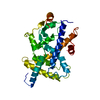
 Components
Components
 Homo sapiens (human) / Cellular location: NUCLEUS
Homo sapiens (human) / Cellular location: NUCLEUS Cell nucleus / Plasmid: PET15B / Species (production host): Escherichia coli / Production host:
Cell nucleus / Plasmid: PET15B / Species (production host): Escherichia coli / Production host: 
 Escherichia coli BL21(DE3) (bacteria) / Strain (production host): BL21 (DE3) / References: UniProt: P37231
Escherichia coli BL21(DE3) (bacteria) / Strain (production host): BL21 (DE3) / References: UniProt: P37231 X-RAY DIFFRACTION / Number of used crystals: 1
X-RAY DIFFRACTION / Number of used crystals: 1  Sample preparation
Sample preparation
 ROTATING ANODE / Type: RIGAKU RUH3R / Wavelength: 1.5418
ROTATING ANODE / Type: RIGAKU RUH3R / Wavelength: 1.5418  : 1.5418 Å / Relative weight: 1
: 1.5418 Å / Relative weight: 1  Processing
Processing :
:  MIRAS / Resolution: 2.9→15 Å / Rfactor Rfree error: 0.013 / Data cutoff high rms absF: 1468010.61 / Isotropic thermal model: RESTRAINED / Cross valid method: THROUGHOUT / σ(F): 0 / Details: BULK SOLVENT MODEL USED
MIRAS / Resolution: 2.9→15 Å / Rfactor Rfree error: 0.013 / Data cutoff high rms absF: 1468010.61 / Isotropic thermal model: RESTRAINED / Cross valid method: THROUGHOUT / σ(F): 0 / Details: BULK SOLVENT MODEL USED Movie
Movie Controller
Controller


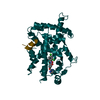


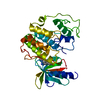
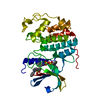
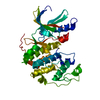
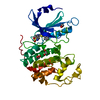

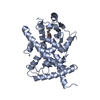
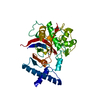
 PDBj
PDBj